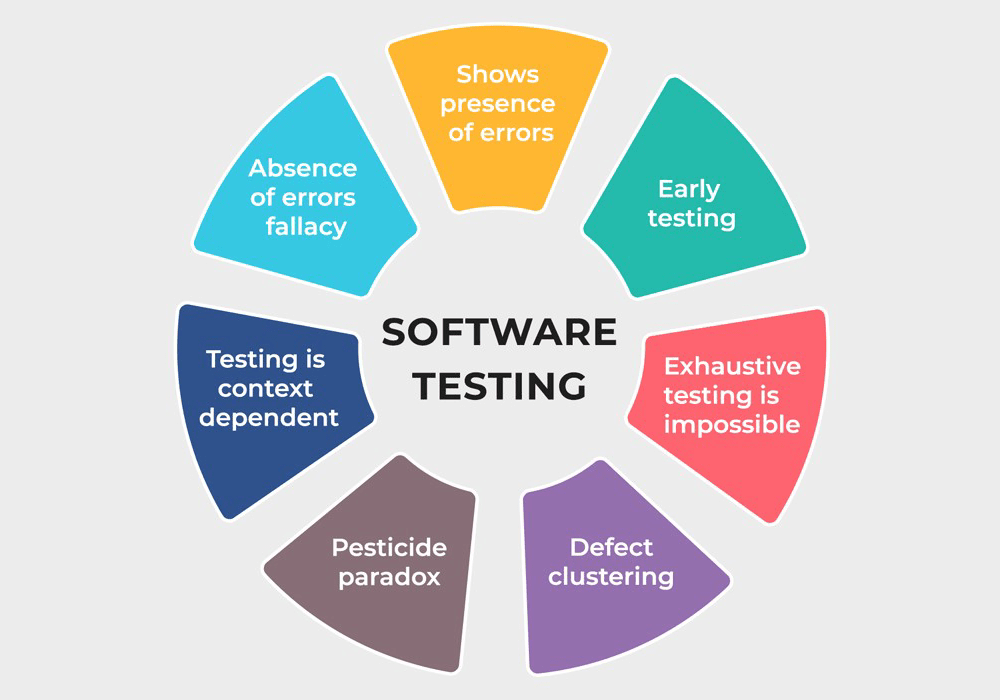7 Principle of Software Testing

“The only certainties in life are death, taxes and bugs in code.” – Anonymous
If you’re a coder, and your life is not a constant juggle between bugs and coffee breaks, you’re not doing it right. Just like anything created by humans, software aren’t flawless. Yet, as professional software developers, it remains our duty to provide end-users with a product that is bug-free (well, almost!)
But, how can we ensure that a product is error-free? How do we eliminate the chances of delivering an end-product with possible bugs?
The solution is simple – Software Testing.
Software testing is one of the most overlooked and underrated aspects of the software development process. Often, we read jokes about how testing is a routine job that requires no talent.
So, in order to debug this particular myth, let us tell you about few mishaps that occurred because a developer thought that his code was too mighty to be tested –
- In the summer of 1996, a seemingly simple software bug caused 823 bank accounts to be credited with 920 million USD.
- In 1994, a Chinese Airline Airbus crashed because of a software bug taking 264 lives.
- British Airways has suffered massive reputation loss due to cancellation and delays in major international flights which took place due to a software bug.
- In one instance, Starbucks was forced to shut down their outlets in the US and Canada due to a software bug in their POS system. They were even forced to sell coffee for free as no transaction could be processed on it.
When we create software, we provide solutions to an existing problem. The only way to ensure that your solution is foolproof is by testing its viability.
Software testing helps a developer in finding roadblocks in the execution of their software plan. Let us give you a step-by-step introduction to software testing.
WHAT IS SOFTWARE TESTING?
Software testing is a process of validating and verifying that software has no bugs, meets the technical requirements set by the guidelines and is as per the user instructions.
It ensures that software is bug and error-free and can run smoothly. Software testing can be categorized in the following steps –
- VERIFICATION/STATIC TESTING: In this step, one verifies whether the software follows the specific function it is meant to follow. For example – “Is our software right?”
- VALIDATION/DYNAMIC TESTING: After verification, one finds out whether the software built is as per the customer’s requirement. For example – “Is our software correct for the customer?”
Once upon a time, the software didn’t work because of bugs and thus, software testing was born. Like every other system, it was developed and modified over time and as of now, there’re two types of software testing present.
- MANUAL TESTING: As the name suggests, manual testing is done when a professional dons the cap of an end-user and try to find out possible bugs and obstacles in the end-use of the software. There’re various stages of manual testing like –
– Unit Testing – Where a single unit of software is tested.
– Integrated Testing – Where the behavior of integrated units in software is tested.
– System Testing – Where the compliance of the entire system with technical requirement is verified
– Acceptance Testing – Where the compatibility of software with user’s requirement is validated.
- AUTOMATED TESTING: Also known as test automation, it is done by using another software to test scripts in order to verify the software product and find out about any possible errors and bugs. It is basically automating the manual testing process. This helps in saving time and cost. Moreover, automated testing is assisted with re-run scenarios which ultimately improves accuracy and decreases the chances of mistakes.
WHY IS SOFTWARE TESTING IMPORTANT?
Developers are, first and foremost, human beings. And, no human can be error-free. This universal truth makes software testing one of the most essential parts of software development.
Over time, software testing has gained the importance it rightfully deserved. We will tell you what makes software testing one of the most essential parts of development –
- IT HELPS SAVE COST – Yes, you heard it right. While many novices argue that software testing is unnecessary and even overpaid job, the researchers say otherwise.
An error found out in the developmental phase helps in eliminating the chances of a big roadblock later. It always costs less to fix a small error than a big bug.
- IT HELPS KEEP DATA SECURED: Data leaks are a cause of major business blunders and a lot of social embarrassment. When a user looks for a software product, they want a trusted and tested software where their data is protected. Moreover, laws and regulations have also become way stricter about data security.
One of the most common bug in any software is how easily it can be hacked to get confidential information. A thoroughly tested software product helps eliminate this possibility and make software trustworthy.
- IT HELPS IN MAINTAINING QUALITY: Why do you create software? To provide solution and make life simpler and easier. The first phase of any developmental cycle is planning where one decides how software is going to help the end-user.
Constant checks and testing ensure that the software remains in compliance with the technical and user requirement so that the end product is of top-notch quality.
- IT HELPS BUILD CUSTOMER LOYALTY: A product with glitches and errors is the worst publicity a firm could ask for. When you provide customer with a smooth and error-free experience, they tend to return and remain loyal. Good reviews and repeat customers are the biggest testimony of a good software and only testing can ensure that.
While it may look like overspending, a team of technically sound software testers is one of the best investments for your business.
7 Principle of Software Testing
The answer is yes. And with this, we finally come to the topic of our blog.
Like every technical practice, there’re basic principles on which software testing is carried out. Let us take you through the seven principles of software testing.
- TESTING SHOWS A PRESENCE OF DEFECTS: Software testing deals with presence of defects and do not talk about absence of defects. Simply explained, as per this principle, testing can help in reducing the probability of undetected defects but it cannot guarantee a 100% correct software because a software may be error-free but it can still not meet the requirement of users.
- ABSENCE OF ERROR – FALLACY: Your software may be 99.99% bug-free but it still may be redundant. Software testing can only tell you if your code meets the requirement you’ve built it upon. However, if you have not followed the requirements thoroughly, the end-product may still be unacceptable even after being bug-free.
- EARLY TESTING: It is advised that the process of software testing should begin as early as possible in the software development cycle. This is advised so as to reduce cost. Early detection of bugs help in cheaper rectification of errors. Ideally, testing should begin as soon as the requirements are set.
- TESTING IS CONTEXT DEPENDANT: No two software applications are similar and every software requires different set of testing methodologies. The testing methods applicable for an e-commerce site will not suit testing of an off-the-shelf android application. Thus, it is said that testing depends largely on the context of the software.
- PESTICIDE PARADOX: What happens when a farmer uses the same mix of pesticides in his/her crop? The pests develop resistance to them and the pesticides becomes ineffective. Similarly, same set of tests, when repeated, can become futile and lead to new errors being unnoticed. Thus, it is advised to keep on reviewing and reshuffling the test methodologies.
- DEFECT CLUSTERING: Pareto principle states the 80% problems are contained in 20% of modules and remaining 20% comes from the other 80% of modules. Hence, the stress is on testing that 20% of the module where most of the errors come from.
- EXHAUSTIVE TESTING IS NOT POSSIBLE: This principle is about embracing the obvious. Testing every possible case is a costly, lengthy and practically impossible. Thus, testing a software’s functionality in all possible inputs and condition is virtually impossible and it is assumed that if a software is smoothly running in some cases, it shall do so in all cases.
CONCLUSION:
There’s a myth that states the principles of testing are not as essential and are an unnecessary study. This is as bogus as the fact that most people found software testing unnecessary.
Principles of testing help in drafting an effective test strategy and ensuring that software testing remains bug-free. Just like driving rules, principles is testing help you perfect the art and science of testing with the right basics. Once you’re an experienced professional, you glide through the process with testing principles ingrained in your mind.
Software testing is an important job and with an ever-growing demand. Professional training can help you start your career in this field and can help you advance and find better opportunities. We, at Gyansetu, Provides you best Selenium Training and Placement.
Till then, may you pass every test of your life error-free!

